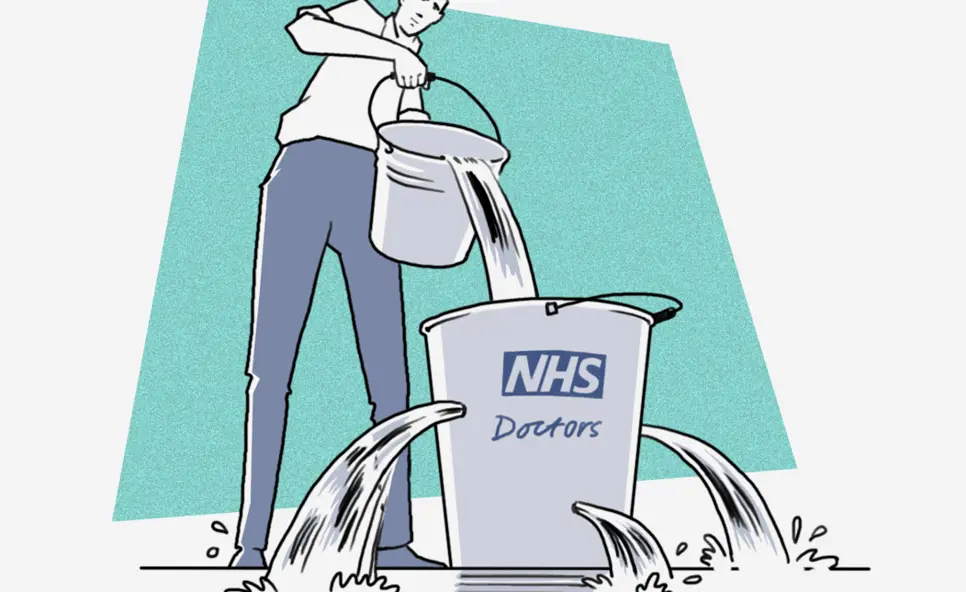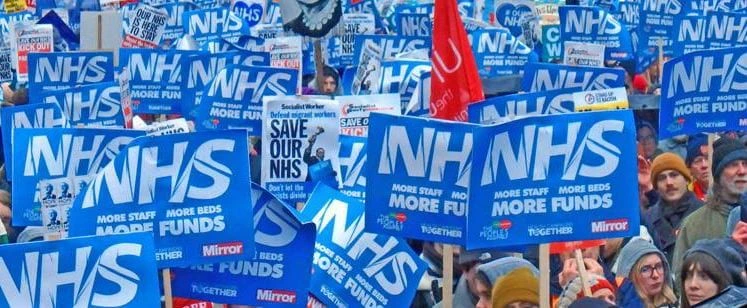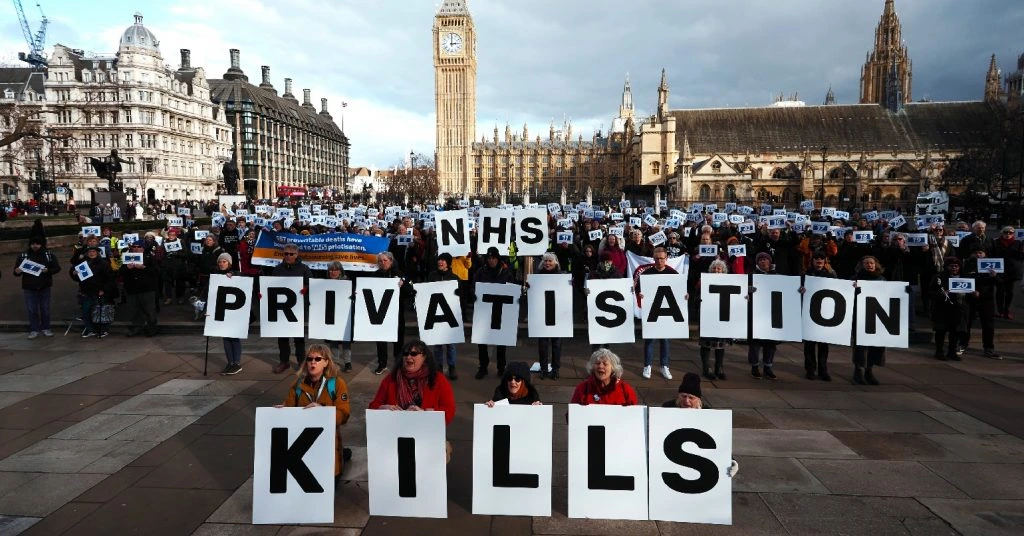Key Findings

Full Findings
Analysis of the causes of NHS staff shortages identified that insufficient funding, insufficient retention and recruitment, growing demand for healthcare, and staff dissatisfaction were all core inter-related reasons for NHS staffing shortages. Of these sources, staff dissatisfaction was the most heavily cited reason for staff shortages (41), followed by insufficient recruitment and retention (37), insufficient funding (21), and growing demand for healthcare (14). Further analysis of staff dissatisfaction identified that burnout causing work-induced poor mental health and issues with pay were the biggest causes of staff dissatisfaction, resulting in strike action which further accentuates staff shortages. Staff dissatisfaction was also found to cause further staff dissatisfaction through a self-sustaining cycle of increasing turnover, increasing workload which then further increases burnout. Therefore, breaking this cycle is crucial in dealing with NHS staff shortages.

Vacancies are rising faster than they can be filled
Issues with pay was found to also be associated with investment and planning, with underinvestment in the NHS being its cause. Moreover, other countries and sectors within the UK economy were found to pay comparably more than the NHS, deepening sentiment amongst workers toward quitting to pursue better opportunities elsewhere. This effect was found to be enhanced due to a reduction in real wages for NHS staff caused by the current cost of living crisis and subsequent high inflation in the UK. Insufficient pay contributed the most data points to the investment and planning theme (25), but the government’s inability to commit to long-term, transparent plans was cited as another important variable (9). In particular, the politicization of the NHS and short-termism were associated with having negative ramifications for NHS funding and planning, worsening staffing shortages. Both themes were found to be associated with the government having other funding priorities and finite resources, with the suggestion that a solution could involve introducing a hypothecation tax to provide designated income for the NHS.
With respect to insufficient recruitment and retention, the former was found to be heavily associated with insufficient funding and the latter was found to be heavily associated with both underinvestment and staff dissatisfaction. Specifically, insufficient retention was found to be heavily associated with the self-sustaining cycle of staff shortages causing staff dissatisfaction causing further staff shortages. Insufficient recruitment however was found to cover a broader spectrum of reasons, which can be divided into two themes; Insufficient overseas recruitment and insufficient domestic recruitment. Insufficient domestic recruitment was largely attributed to insufficient pay, insufficient medical school places, and potential employees seeking more prosperous oversees or private sector employment instead. NHS employees seeking employment elsewhere for greater prospects was also found to be significant in insufficient oversees recruitment. The other key factor identified as being associated with insufficient international recruitment is the political and migratory effects of Brexit on the employment of international workers. Overarchingly though, the comparatively bad prospects of UK employment with respect to pay, working conditions and the economic state of the UK was identified as the supreme criteria limiting international recruitment. A less prevalent cause of insufficient recruitment was also a global shortage of healthcare workers for certain functions at the NHS.

Underpaid and overworked staff have participated in several protests
The global shortage of healthcare workers limiting recruitment was found to be heavily associated with the growing demand for healthcare. Particularly, an ageing population, increase in lifestyle related illness, and COVID-19 related admissions and backlogs were found to be key culprits in causing an increase in demand. The direct effect of increasing demand for healthcare is the requirement of more staff to deal with increased patients, therefore poor retention and insufficient levels of recruitment stand to amplify the effects of growing demand.
The effects of staff shortages could primarily be grouped under two themes; negative staff experiences and negative patient experiences. With respect to negative patient experiences, several interrelated themes were pronounced within the analysis pertaining to worsening patient outcomes, increasing NHS waiting times and causally a loss of trust in the NHS. Though opposingly, these effects have implications for encouraging patients to seek alternative private healthcare, reducing the burden on NHS services, the overall ramifications are negative. In the case of negative staff experiences, the direct effects were found to be decreasing worker satisfaction and a risk to staff safety, both found to be associated with further accentuating staff shortages. A third theme was also identified as staff shortages being a threat to the sustainability of the NHS, this theme was directly associated with the potential need to privatise the NHS as a worst-case scenario solution if the NHS’ problems continue to get worse.
The privatisation of the NHS was found to be the most drastic solution as it was associated with various negative ramifications when implementing including negative political effects, increasing healthcare inequality and resultantly the potential for a substantial reduction in healthcare access. Assessing the solutions identified through analysis, four key themes emerged; Boosting recruitment, improving efficiency, improving investment and planning, and implementing policy changes.

NHS privatisation would likely translate to worsening outcomes for the poorest and most vulnerable
Emergent themes related to improving planning and investment included improving long-term planning, increasing investment through taxation and charges, and privatisation of the NHS. Improvement in long-term planning and planning transparency was found to be a solution to help alleviate the pressure NHS staff shortages cause by allowing trusts to adequately prepare for the future healthcare climate. Resultantly, this has direct implications in relation to reducing the effects that COVID-19 and other uncertainties are creating. However, the main barriers to implementing better planning were identified as being long staff training times affecting the ability to forecast staff numbers and uncertainty over future healthcare requirements.
Increased taxation and charges were found to be correlated with improving pay, staff satisfaction and expanding recruitment. Moreover, there is large scope for variation in approach in introducing them, allowing for greater flexibility in implementing them as a solution. Analysis identified the following as possible avenues to explore; Hypothecation taxes, increased corporation taxes, increased national insurance payments, sin taxes, reducing tax avoidance, increasing prescription charges, charging for the GP and hospital stays, and fining for missed appointments. All these taxes and charges would increase funding for the NHS, hence alleviating the effects of underfunding on staff shortages dependent upon their extent of implementation. Moreover, up-front charges to patients were seen to be correlated with a reduction in moral hazard, resulting in lower demand, particularly with respect to lifestyle related admissions and taxes. However, the key barrier to implementing funding initiatives is their political and societal implications, particularly with respect to up-front charges. Expanding upon this, implementing taxation and additional charges in the context of a cost-of-living crisis stands to worsen quality of living for many, increasing health inequality dependent upon the type and extent of taxation or charges used. Moreover, implementing up-front charges was identified as affecting the elderly the most, causing the government championing the changes to lose political favour with the elderly, dissuading government level changes. Furthermore, using additional government revenue solely for the NHS stands to create an opportunity cost to other underfunded sectors. Resultantly, unless a hypothecation tax or similar is implemented, only some of the increased funding is likely to go to the NHS to minimise said opportunity costs, reducing effectivity.

Increased taxation and charges are one of the most effective ways to improve NHS services
Improving efficiency at the NHS was found to be closely associated with resolving staff shortages by better utilising current resources through vices such as reducing unnecessary admissions and hospital stays. Though staff noted that they felt there was not much room to further increase efficiency. Therefore, though efficiency gains provide an ideal solution with no significant drawbacks identified within the analysis, the extent to which they can be realised stands to be severely limited.
With respect to improving recruitment and retention, a solution incorporating these aspects stands to either reduce staff dissatisfaction, improving retention and breaking the self-sustaining turnover cycle or boost training and recruitment levels. With respect to improving staff satisfaction, increasing pay, reducing discrimination, incorporating flexible working initiatives, and promoting greater teamwork were seen as implementable resolutions. Consequentially, to significantly decrease the effects of overworking, improving staff satisfaction and compounding retention rates, steps must first be taken to resolve issues with staff pay, whilst simultaneously attempting to expand recruitment. However, again the key drawback of increasing retention is funding, since a pay rise was found to be the primary actionable way to increase retention, meaning the extent implementation is possible is heavily dependent upon the extent funding is increased. In the case of recruitment, initiatives identified primarily pertained to increased investment in training, increased medical school places, financial aid to countries the NHS recruits from and policy changes. Therefore, again the primary barrier to improving recruitment is the aforementioned funding increases and the associated costs they bring. Regarding policy changes, policies to improve ease of migration for healthcare workers and promote healthier lifestyles were related to improving recruitment and reducing demand on healthcare services respectively. However, changing migration policies has implications for Brexit and going against what the country voted for, associating it with negative political implications.
